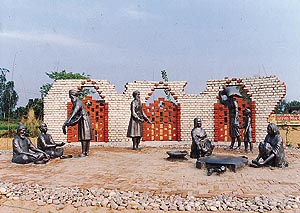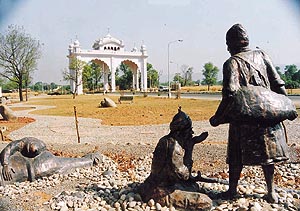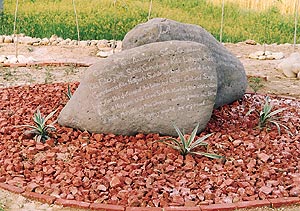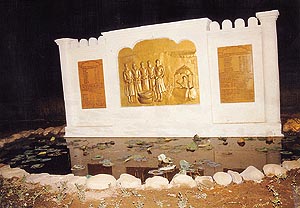| |
 Interestingly, the project was
conceived earlier by the Punjab Government which wanted
the entry and exit to the historic city adorned. The
work, however, could not be executed until this year when
tenders were floated. The project was finally allotted to
a city-based landscaping expert Sonia Dhami, who is the
brain behind the entire structure as it looks today
— a perfect supplement to the architectural beauty
of the existing gates. The project has not only shaped
into a technical marvel, but it also offers a wonderful
insight into what Sikhi is all about. And the
interesting part is that it enlightens and informs via
visually appealing artwork, comprising life-size
statutes, relief panels, stone wall panels and engraved
rocks and boulders. The work seems to have been planned
to the last detail, as is reflected in the meaningful
portrayal of every piece of concrete that has been used.
There is a main focal point which is the castle wall and
this wall lies surrounded by smaller focal points in the
form of panels, engravings, rocks and boulder
compositions. The landscape has free-flowing curves which
have been linked with the focal points, creating an
interesting visual sequence. Interestingly, the project was
conceived earlier by the Punjab Government which wanted
the entry and exit to the historic city adorned. The
work, however, could not be executed until this year when
tenders were floated. The project was finally allotted to
a city-based landscaping expert Sonia Dhami, who is the
brain behind the entire structure as it looks today
— a perfect supplement to the architectural beauty
of the existing gates. The project has not only shaped
into a technical marvel, but it also offers a wonderful
insight into what Sikhi is all about. And the
interesting part is that it enlightens and informs via
visually appealing artwork, comprising life-size
statutes, relief panels, stone wall panels and engraved
rocks and boulders. The work seems to have been planned
to the last detail, as is reflected in the meaningful
portrayal of every piece of concrete that has been used.
There is a main focal point which is the castle wall and
this wall lies surrounded by smaller focal points in the
form of panels, engravings, rocks and boulder
compositions. The landscape has free-flowing curves which
have been linked with the focal points, creating an
interesting visual sequence. In
description, the site may be a maze of concrete, but in
concept it is a virtual 10-minute journey through the
three centuries of the Khalsa. The layout depicts almost
all aspects of history relevant to the fraternity of
Saint Soldiers. It reflects the Khalsa's travails and
tribulations; its victories and accomplishments. The
project is a live screen which flashes not only the
martial fervour of the Khalsa, who valiantly fought the
enemy in the battlefield, but also shows his softer
humane side. Bhai Kanhaiya is shown offering water to
enemy soldiers. When Bhai Kanhaiya was confronted by Guru
Gobind Singh on this account, he explained his conduct
saying, "Master, since I have come in touch with
you, I see God everywhere and His entire creation as His
children. Amongst the wounded, I fail to distinguish
between a friend and a foe." In
description, the site may be a maze of concrete, but in
concept it is a virtual 10-minute journey through the
three centuries of the Khalsa. The layout depicts almost
all aspects of history relevant to the fraternity of
Saint Soldiers. It reflects the Khalsa's travails and
tribulations; its victories and accomplishments. The
project is a live screen which flashes not only the
martial fervour of the Khalsa, who valiantly fought the
enemy in the battlefield, but also shows his softer
humane side. Bhai Kanhaiya is shown offering water to
enemy soldiers. When Bhai Kanhaiya was confronted by Guru
Gobind Singh on this account, he explained his conduct
saying, "Master, since I have come in touch with
you, I see God everywhere and His entire creation as His
children. Amongst the wounded, I fail to distinguish
between a friend and a foe."
Yet another scene
explains the dynamics of langar, the Sikh ritual
which underlines the principle of universal brotherhood.
There are a series of depictions, portraying the Sikh
tenets which revolve around three main acts — kirat
karo, naam japo, wand chhako. The panels also give a
detailed account of Guru Nanak Dev and his nine
successors. A description of how the Khalsa came into
being lies engraved upon rocks.
 As one walks through the garden, one finds
that even the plants have been chosen to serve a useful
purpose. The plants grown symbolise the scenarios
projected — the battlefield scene is depicted by the
thorny cacti, while the purity of the Khalsa is portrayed
by a lotus pond. As one walks through the garden, one finds
that even the plants have been chosen to serve a useful
purpose. The plants grown symbolise the scenarios
projected — the battlefield scene is depicted by the
thorny cacti, while the purity of the Khalsa is portrayed
by a lotus pond.
The uniqueness of Sikhi
stands magnified through every little work that has been
executed. Each section of the landscape — right from
the relief panels, depicting the baptism of Panj
Piaras (Bhai Daya Singh, Bhai Dharam Singh, Bhai
Himmat Singh, Bhai Mohkam Singh and Bhai Sahib Singh) and
the martial zeal of Holla Mohalla to the rocks
engraved with various achievements of Guru Gobind Singh
— furthers one common objective of enlightening the
visitor on the historical events related to Anandpur
Sahib. The engravings speak of the significance as well
as the location of various gurdwaras of the holy town.
The sequence starts with
the detail of Guru Teg Bahadur, the ninth Guru who
founded the settlement of Anandpur Sahib by buying the
land of Makhowal village on the banks of the Shatdrav
(Sutlej). Set against the picturesque Naina Devi range,
this was the place where Guru Gobind Singh created the
Khalsa. Then there are engravings about Gurdwara Guru Ke
Mahal, the shrine which marks the residence of Guru Teg
Bahadur. There is information on the three gurdwaras
— Gurdwara Bhora Sahib, Gurdwara Manji Sahib and
Gurdwara Damdama Sahib. It was at this place that Guru
Teg Bahadur gave a hearing to the Kashmiri Pandits'
account of the forcible conversions they were being
subjected to by Aurangzeb.
 Following
this, is information on Guru Teg Bahadur’s martyrdom
and Gurdwara Sis Ganj Sahib. Engraved on the rocks is the
account of the day when Guru Teg Bahadur's severed head
was brought to Anandpur Sahib by Bhai Jaita. Last, but
not the least, is the historic Akal Bunga from
where Guru Gobind Singh called upon his followers to
fight injustice and tyranny. Following
this, is information on Guru Teg Bahadur’s martyrdom
and Gurdwara Sis Ganj Sahib. Engraved on the rocks is the
account of the day when Guru Teg Bahadur's severed head
was brought to Anandpur Sahib by Bhai Jaita. Last, but
not the least, is the historic Akal Bunga from
where Guru Gobind Singh called upon his followers to
fight injustice and tyranny.
The rocks also talk
about Gurdwara Kila Anandgarh Sahib, Gurdwara Kila
Fatehgarh Sahib, Gurdwara Kila Lohgarh Sahib and Gurdwara
Kila Holgarg Sahib which mark the sites where forts were
built by Guru Gobind Singh for the defence of the town.
In 1700, the Guru commenced the Holla Mohalla
celebrations at Holgarh, where martial games and horse
riding events were organised.
The entire place exudes
warmth, and rightly so, for it is a labour of love, a
dream come true for Sonia Dhami and her team of workers,
including architect Sukumar  Jeirath, who had been camping in the city
for the past two months. The art work has been executed
by Amarjit Virdi and Manjit Singh in consultation with
renowned Punjabi painter Jarnail Singh. The engravings,
which are concise and well drafted, have been composed in
consultation with Prof Manjit Singh, Jathedar of Takht
Sri Kesgarh Sahib. Jeirath, who had been camping in the city
for the past two months. The art work has been executed
by Amarjit Virdi and Manjit Singh in consultation with
renowned Punjabi painter Jarnail Singh. The engravings,
which are concise and well drafted, have been composed in
consultation with Prof Manjit Singh, Jathedar of Takht
Sri Kesgarh Sahib.
The efforts of 80
labourers, six masons and 15 gardeners have produced a
landscape that is a visual treat and imparts rhythm and
harmony to the surroundings. As one walks out of the
place, its imprint remains in the mind and so does Guru
Gobind's message:
"O Lord bless me
with this boon that I may never be deterred from doing
pure deeds,
Fearless and determined to win, I should go to battle,
with divine wisdom guiding my mind,
I crave ever to sing your glories and when comes the
final end,
I should die heroically on the battlefield.
|

